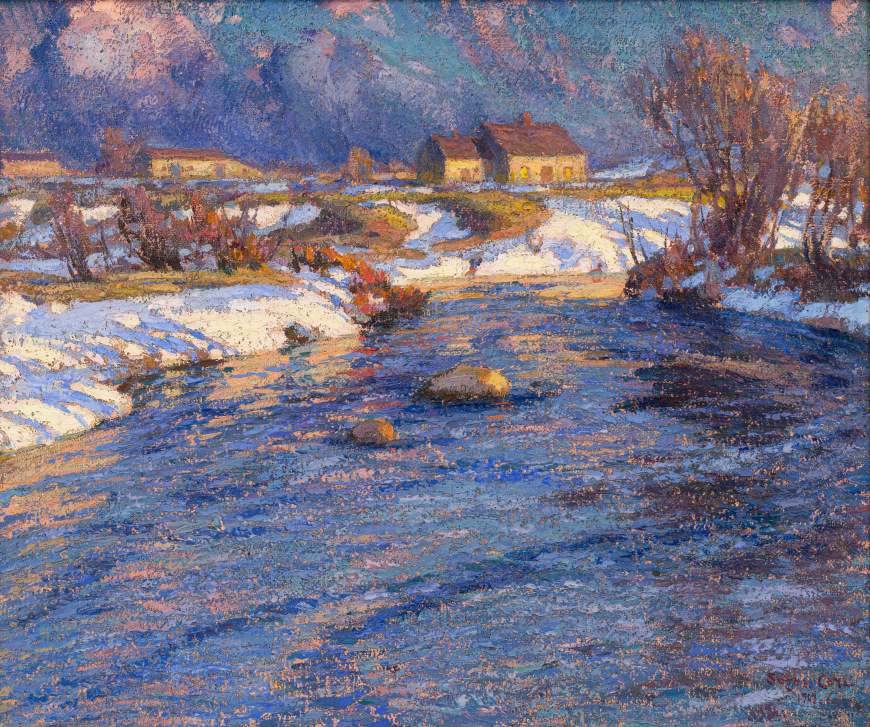50.8 x 61 cm
Inscriptions
signed and dated, ‘Suzor Coté/ 1909’ (lower right)Provenance
Watson Art Galleries, Montreal, Inventory No. 12939, sold as Early Spring Arthabaska River
Collection of Mr. Arthur Décary, Montreal
Watson Art Galleries, Montreal
Collection of Mr. François Dupré, acquired from the above 12 September 1946
Heffel Fine Art Auction House, Fine Canadian Art, 24 November 2011, lot 122
Galerie Walter Klinkhoff Inc., Montreal
Property of a Distinguished Montreal Collector
Exhibitions
Montreal, Watson Art Galleries, 16-26 November 1927, exhibited as Winter Sunglow: Arthabaska, cat. no. 20.
Montreal, École des beaux-arts de Montréal, Marc-Aurèle Suzor-Coté Retrospective, 3 - 20 December 1929, exhibited as Winter Sun Glow (Arthabaska), cat. no. 47.
Literature
Albert Laberge, "Inauguration officielle de l'exposition Suzor-Coté par l'honorable Athanase David", La Presse, 4 December 1929, p. 1 and 11.
"Versatility Marks Show of Art Works. Paintings, pastels, drawings and bronzes by M.A. Suzor- Coté, R.C.A. at Watson Galleries", The Gazette, 21 November 1927, p.5.
"Suzor-Coté's work in rich profusion", The Gazette, 4 December 1929, titled as Winter Sunglow, p. 6.
Hughes de Jouvancourt, Suzor-Coté (Montreal: Éditions de la Frégate, 1967), titled as March Thaw, 92 [reproduced].
Hughes de Jouvancourt, Suzor-Coté (Montreal: Stanké, 1978) titled as Dégel de mars, 27 [reproduced].
Jean-Guy Dagenais, editor, Rodolphe Duguay Journal, 2002, p. 78.
Laurier Lacroix, Suzor-Coté: Light and Matter (Ottawa: National Gallery of Canada, 2002), 188 - 193, Settlement on the Hillside p. 179 [reproduced], and Winter Landscape p. 181 [reproduced].
Jeffrey Spalding, "Immaculate Misconception," in Riopelle, edited by Guy Cogeval (Montreal: The Montreal Museum of Fine Arts, 2006), 15.
Marc-Aurèle Suzor-Coté, Crépuscule, Arthabaska (Winter Sunglow Arthabaska)
by Laurier Lacroix
As Jean-René Ostiguy noted in his monograph for the National Gallery of Canada, Winter Landscape (1909), Suzor-Coté rose to fame for his winter scenes. The 40-year-old artist was at the height of his career, and his technical mastery was unparalleled, as was his vision of the Canadian landscape. According to S. Morgan-Powell, critic for the Montreal Star: “He [Suzor-Coté] is the ablest painter of winter scenes in Canada today. Note even excepting Mr. Cullen, for whose work I entertain a warm admiration. Mr. Suzor-Coté’s snow always hold the correct winter light. He gives a texture that is overwhelmingly realistic. His skies, too, are admirable in their breadth and the warmth coloring. He makes headway all the time, and is bound to establish himself as a distinctively Canadian artist.” (November 22, 1913)
The scenery of the Arthabaska region was an opportunity for Suzor-Coté to put into practice the knowledge he acquired during the decade he spent in France, where he was introduced to Post-Impressionism. His style was characterized by a light colour palette, the use of drawing in his painted forms and bold brushwork.
Using a spatula and a dry brush, the artist emphasized the important role of matter in the art of painting, by applying coloured strokes that are juxtaposed or blended to create the desired image. The flow of the river, for example, occupies the lower third of the painting. As in his masterpiece Crépuscule, Arthabaska (Winter Sunglow Arthabaska), the water is transformed into an abstract movement created by the overlapping of long, slightly curved strokes made with the spatula.
Suzor-Coté painted the first settlements on the banks of the Nicolet River on a few occasions. Here, the sun beams directly down on the house and farm that rise above the high horizon line. The colours of the sky are mirrored by the river, and they are brought together by a white strip of snow with pale, bluish shadows.
For Suzor-Coté, winter is an opportunity to observe the variations of light on the snow at different times of day and season. Here, the golden light is a sign that the snow is melting—the moment when the long months of hibernation give way to new life. It is a landscape of hope and peacefulness, dominated by blues and golds and punctuated by touches of ochre and orange. The landscape is a harmonious mix of blue, gold and white.
Laurier Lacroix
Laurier Lacroix C.M. is professor emeritus at Université du Québec à Montréal, where he taught art history and museology. Among his achievements are exhibitions devoted to Ozias Leduc and Suzor-Coté, as well as Painting in Montreal, 1915–1930, Les arts en Nouvelle-France, Le fonds de tableaux Desjardins, L’atelier comme création. Histoires des ateliers d’artistes au Québec and Becoming Montreal, The 1800s Painted by Duncan. He is also interested in contemporary art and has curated works by Irene F. Whittome, Marc Garneau, Pierre Dorion, Guy Pellerin, Robert Wolfe, Micheline Beauchemin and Lisette Lemieux, among others. Lacroix was the recipient of the Career Award of the Société des musées québécois and the Prix Gérard-Morisset. He is a member of the Société des Dix and the Académie des lettres du Québec.




















